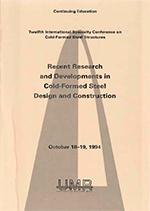Location
Saint Louis, Missouri
Session Dates
18 Oct 1994
Abstract
Nonlinear time step dynamic analyses have been performed on 24 rectangular single-storey steel framed buildings including a metal roof deck diaphragm and steel bracing bays along their exterior walls. The structures were designed according to current Canadian codes and were subjected to site specific ensembles of historical earthquake accelerograms. The analyses indicated that larger in-plane deformations and bending moments developed in the diaphragm compared to the values expected from the equivalent lateral force procedure commonly used in design. The distribution of the shear forces in the diaphragm was also found to deviate significantly from the linear distribution assumed in design. In addition, the ductility demand in the bracing bents exceeded the amount predicted by nonlinear analyses performed on equivalent single-degree of freedom systems. Based on these results, preliminary design guidelines have been proposed for predicting the deformations, moments and shear forces in roof diaphragm as well as for confining inelastic action in the vertical bracing elements.
Department(s)
Civil, Architectural and Environmental Engineering
Research Center/Lab(s)
Wei-Wen Yu Center for Cold-Formed Steel Structures
Meeting Name
12th International Specialty Conference on Cold-Formed Steel Structures
Publisher
University of Missouri--Rolla
Document Version
Final Version
Rights
© 1994 University of Missouri--Rolla, All rights reserved.
Document Type
Article - Conference proceedings
File Type
text
Language
English
Recommended Citation
Tremblay, R. and Stiemer, S. F., "Seismic Response of Single-storey Steel Buildings" (1994). CCFSS Proceedings of International Specialty Conference on Cold-Formed Steel Structures (1971 - 2018). 6.
https://scholarsmine.mst.edu/isccss/12iccfss/12iccfss-session10/6
Seismic Response of Single-storey Steel Buildings
Saint Louis, Missouri
Nonlinear time step dynamic analyses have been performed on 24 rectangular single-storey steel framed buildings including a metal roof deck diaphragm and steel bracing bays along their exterior walls. The structures were designed according to current Canadian codes and were subjected to site specific ensembles of historical earthquake accelerograms. The analyses indicated that larger in-plane deformations and bending moments developed in the diaphragm compared to the values expected from the equivalent lateral force procedure commonly used in design. The distribution of the shear forces in the diaphragm was also found to deviate significantly from the linear distribution assumed in design. In addition, the ductility demand in the bracing bents exceeded the amount predicted by nonlinear analyses performed on equivalent single-degree of freedom systems. Based on these results, preliminary design guidelines have been proposed for predicting the deformations, moments and shear forces in roof diaphragm as well as for confining inelastic action in the vertical bracing elements.



